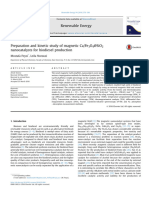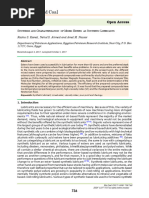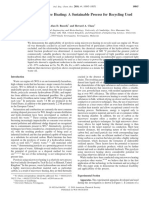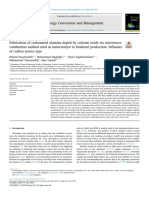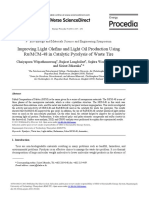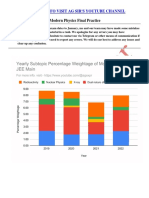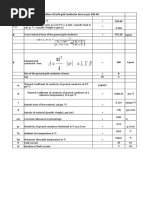Catalyst
Catalyst
Uploaded by
DussadeeCopyright:
Available Formats
Catalyst
Catalyst
Uploaded by
DussadeeOriginal Description:
Copyright
Available Formats
Share this document
Did you find this document useful?
Is this content inappropriate?
Copyright:
Available Formats
Catalyst
Catalyst
Uploaded by
DussadeeCopyright:
Available Formats
The 4th TIChE International Conference 2014
"Changes: Cleaner Energy, Leaner Processes, Better Living"
Chiang Mai, Thailand, December 18-19, 2014
Characterization and Catalytic Activity Studies of Neodymium Oxide
Catalyst for Biodiesel Production
Teerapong Ajpakdee, and Dussadee Rattanaphra*
Research and Development Division, Thailand Institute of Nuclear Technology,
Phathumtani, 12120, Thailand
*Corresponding author: E-mail drattanapra@yahoo.com
Abstract The neodymium-EDTA solution obtained
from decomposition of Thai monazite ore by alkali
method and using ion exchange technique as
purification process was used as raw material to
prepare neodymium oxide (Nd2O3) catalyst. The
catalyst was synthesized by oxalate precipitation
method. Effect of calcination temperature (500, 600,
800, 900 and 1000 oC) on structure and properties of
Nd2O3 catalyst was studied. The obtained catalyst was
characterized by X-ray diffraction (XRD), BrunauerEmmett-Teller (BET) method, Thermogravimetric
analysis (TGA) and Scanning electron microscope
(SEM). The result showed that the prepared catalyst
was very fine. The average crystallite size of Nd2O3
catalyst was about 46.77 nm. The catalyst was used to
catalyze the transesterification of palm oil with
methanol to biodiesel production. It was found that the
high fatty acid methyl ester (biodiesel) content of
97.2% was obtained under the conditions: molar ratio
of methanol to oil of 30:1, catalyst loading of 10 wt%,
reaction temperature of 200 oC, reaction pressure of 39
bar and stirring rate of 600 rpm for 5 h.
Keywords: neodymium oxide catalyst, characterization,
catalytic activity, and biodiesel.
I.
INTRODUCTION
Due to the increasing of conventional diesel
consumption, the running out of fossil fuel and the rising
of environmental concerns, an alternative diesel fuel is
becoming more popular. Biodiesel is a viable and
attractive alternative fuel [1-2]. It can be derived from
various renewable sources including vegetable oils, animal
fats and recycled cooking oils. Biodiesel is obtained
through transesterification reaction of vegetable oils and
low molecular weight alcohol (usually methanol) in the
presence of a catalyst [3]. Biodiesel shows clear advantage
over conventional diesel. It is biodegradable and naturally
non-toxic [4]. One of the most advantages of biodiesel is
that it reduces the emission profile including carbon
monoxide (44%), sulfur oxide (100%), unburned
hydrocarbons (68%), particulate matter (40%) and
polycyclic aromatic hydrocarbons (PAHs) (80-90%) [5].
Moreover, biodiesel is safer to handle and store than
petroleum diesel fuel because it is higher flash point (over
150 oC) than petroleum diesel fuel (77 oC) [6].
The catalyst used to produce biodiesel can be divided
into two main types: homogeneous and heterogeneous.
Homogeneous catalysts such as NaOH and KOH are
favored to catalyze biodiesel reaction due to its high
activity, its selectivity and its mild reaction conditions (at
low reaction temperature and atmospheric pressure) [7].
However, the use of homogeneous catalysts cause
undesired soap formation through the hydrolysis of esters,
which reduces the biodiesel yield and causes significant
difficultly in the separation of ester and glycerol. Besides,
the removal of the catalyst after reaction is technically
difficult and the huge amount of wastewater is generated
in order to separate and clean the products [8]. These
limitations can be overcome by using a heterogeneous
catalyst. Heterogeneous catalysts have several advantages
over homogeneous catalyst: simple catalyst recovery,
catalyst reusability, simple production purification and a
simple glycerol recover. Moreover, it requires less energy
and water consumption that lead to safer, cheaper and
more environmental friendly approach [7].
Neodymium oxide (Nd2O3) has various applications in
numerous scientific and industrial fields. It is used as
luminescent materials, protective coatings, catalysts or
catalyst modifiers and components for advanced ceramic
materials [9-10]. The applications of Nd2O3 based catalysts
include dehydrogenation, hydrogenation and esterification
[11]. In addition, it has been used as a catalyst for
biodiesel production [12-14].
In this work, pure Nd2O3 catalyst was prepared by
oxalate precipitation method. The catalyst calcined at
The 4th TIChE International Conference 2014
"Changes: Cleaner Energy, Leaner Processes, Better Living"
Chiang Mai, Thailand, December 18-19, 2014
different temperatures was characterized using XRD,
TGA, BET and SEM. The catalytic activity of pure Nd2O3
catalyst in transesterification of palm oil with methanol
was investigated.
II.
MATERIALS AND MATHODS
1. Preparation of Nd2O3 catalyst by oxalate precipitation
method
A solution of 10 wt% of oxalic acid was added
dropwise to1400 ml of Nd in EDTA solution as obtained
from the decomposition of monazite ore process under
constant stirring until a pH of 3-4. After complete
precipitation, a white precipitate of neodymium oxalates
were filtrated and then washed with distilled water several
times as well as were dried at 110 oC for 12 h. Finally, the
samples were calcined at different temperatures (500, 600,
800, 900 and 1000 oC) for 3 h.
2. Sample Charecterization
Powder X-ray diffraction (XRD) patterns were recorded
on a Panalytical, XPert PRO equipped with Cu K
radiation ( = 1.5406 ) operating at 45 kV and 40 mA.
The measurements were performed in the 2 range of 2090o. The TGA analysis was performed on a Mettler Toledo,
TG/SDTA 851e in the range of 25-1100 oC and the heating
ramp of 20 oC/min. The specific surface area and total pore
volume were measured by BET surface area and BJH
method using surface area analyzer (Autosorb-1,
Quantachrome). The surface morphology was observed by
scanning electron microscopy, SEM (S-3400N, HITACHI).
4. Analysis of biodiesel
The fatty acid methyl ester contents (FAME) in the
samples were quantified by using a GC-MS (Algilent,
6890) equipped with a HP-5 capillary column (30 m x 0.25
mm x 0.25 m). Helium was used as a carrier gas. The
oven temperature was programmed from 120 oC to 180 oC
at 20 oC/min and then to 280 oC at 5 oC/min, and held for 3
min. The injector and interface temperature was 280 oC.
The IE ionic source temperature was 230 oC. The
compounds were identified by mass spectrometry in both
SCAN and SIM mode. Spectra of the compounds was
obtained and compared with those in library.
III.
RESULTS AND DISCUSSION
Figure 1 shows the XRD patterns of Nd2O3 calcined at
different temperatures. A monoclinic structure of
Nd2O2CO3 was observed when the calcined temperature
was at 500 and 600 oC, according to JCPDS card No. 230421 and 37-0806 respectively. At the calcined temperature
higher than 800 oC, the crystal structure of Nd2O3 was
observed. A sharp diffraction peak was observed at around
2 = 26.89, 29.83, 30.81, 40.55, 47.47 and 53.53. All of the
diffraction peaks can be indexed to a hexagonal structure,
which matched well with the standard data (JCPDS card
No. 00-041-1089). All the sharp peaks of the powder
indicated that the crystallization was perfectly achieved.
3. Synthesis of biodiesel
Synthesis of biodiesel was investigated using a 600 ml
Parr stirred batch reactor (model 4568) equipped with a
magnetic stirrer drive, a four-blade impeller and a
temperature controller. Initially, 100 g of palm oil and
catalyst were charged into a reactor. After the reactor was
closed, nitrogen was purged to remove the air from the
reactor. When the reactant and catalyst were heated to the
desired reaction temperature, with constant stirring rate of
600 rpm, nitrogen was introduced to pressurize the system
to ensure that the reactants were forced to be liquid. The
reaction was started when methanol was added into the
reactor vessel. After the reaction completion, the sample
was separated from catalyst and glycerol by centrifuge.
The final product was obtained after removal of excessive
methanol.
Figure 1 XRD patterns of Nd2O3 calcined at different
The average crystallite size of Nd2O3 powder was
estimated by the Scherrer equation as follows:
(1)
The 4th TIChE International Conference 2014
"Changes: Cleaner Energy, Leaner Processes, Better Living"
Chiang Mai, Thailand, December 18-19, 2014
where
is the average crystallite size of Nd2O3, =
0.154 nm is the X-ray wavelength of Cu K, is the fullwidth of the peak measured at half maximum intensity
(FWHM) and
is the Braggs angle of the peak, was
about 46.77 nm.
TGA curve of neodymium oxalate (Nd2(C2O4)3.H2O) is
illustrated in Figure 2. The thermal decomposition of
Nd2(C2O4)3..H2O occurred via a three stages process. The
first stage was the dehydration process in the temperature
range of 40-300 oC with weight loss of 24.67%. The
second step located approximately between 300-605 oC
with weight loss about 27.69%, which can be assigned to
the decomposition of Nd2(C2O4)3 to the intermediate
Nd2O2CO3. The third stage beginning at 605 oC and
completing at 752 oC with weight loss 3.54% can be
attributed to the decomposition of Nd2O2CO3 to Nd2O3.
This result was in good agreement with the XRD data.
However, the calcination temperature up to 850 oC is
necessary to convert the remaining Nd2O2CO3 to pure
Nd2O3 [14].
Table 1 shows the BET surface area of Nd compound
calcined at different temperatures. It can be seen that the
BET surface area of Nd2O3 decreased from 8.09 to 4.79
m2/g with the increasing of calcination temperature from
800 to 1000 oC.
SEM images of Nd2O3 calcained at 900 oC are shown
in Figure 3. The SEM photograph of Nd2O3 showed non
uniform sizes and shapes. However, the sizes of most
particles were very fine.
Figure 3 SEM images of Nd2O3 calcined at 900 oC
Pure Nd2O3 catalyst calcined at 900 oC was used to
catalyze transesterification of palm oil and methanol. This
catalyst showed high activity with fatty acid methyl ester
content of 97.2% under the conditions: molar ratio of
methanol to oil of 30:1, catalyst loading of 10 wt%,
reaction temperature of 200 oC, reaction pressure of 39 bar
and stirring rate of 600 rpm for 5 h.
IV.
Figure 2 TGA plot of neodymium oxalate
Nd2(C2O4)3..H2O.
Table 1 BET surface area Nd compound calcined at
different temperatures
CONCLUSIONS
Pure neodymium oxide prepared by oxalate
precipitation presented a promising potential as catalyst in
transesterification of palm oil with methanol to produce
biodiesel. Under the conditions as follows: molar ratio of
methanol to oil of 30:1, a catalyst loading of 10 wt%, a
reaction temperature of 200 oC, a reaction pressure of 39
bar and a stirring rate of 600 rpm for 5 h. The high fatty
acid methyl ester content of 97.2% was obtained.
Calcination
temperature (C)
Nd compound
BET surface
area (m2/g)
500
Nd2O2CO3
14.09
ACKNOWLEDGMENT(S)
600
Nd2O2CO3
8.09
800
Nd2O3
8.04
Financial support from Thailand Institute of Nuclear
Technology is gratefully acknowledged.
900
Nd2O3
6.16
1000
Nd2O3
4.79
The 4th TIChE International Conference 2014
"Changes: Cleaner Energy, Leaner Processes, Better Living"
Chiang Mai, Thailand, December 18-19, 2014
REFERENCES
[1]
[2]
[3]
[4]
[5]
[6]
[7]
Leung, D.Y.C., Wu, X. and Leung, M.K.H. A review
on
biodiesel
production
using
catalyzed
transesterificaion, Applied Energy, 87, 2010, 10831095.
Santori, G., Nicola, G.D., Moglie, M. and Polpnara,
F. A review analyzing the industrial biodiesel
production practice starting from vegetable oil
refining, Applied Energy, 92, 2012, 109-132.
Bharathiraja, B., Chakravarthy, M., Kumar, R.R,
Yuvaraj, D., Jayamuthunagai, J., Kumar, R.P. and
Palani, S. Biodiesel production using chemical and
biological methods A review of process, catalyst
acyl acceptor, source and process variables,
Renewable and Sustainable Energy Reviews, 38,
2014, 368-382.
Atabani, A.E., Silitonga, A.S., Badruddin, I.A.,
Mahlia, T.M.I., Masjuki, H.H. and Mekhilef, S. A
comprehensive review on biodiesel as an alternative
energy resource and its characteristic, Renewable
and Sustainable Energy Reviews, 16, 2012, 20702093.
Talebian-Kiakalaieh, A., Amin, N.A.S. and
Mazaheri, H. A review on novel process of biodiesel
production from waste cooking oil, Applied Energy,
104, 2013, 683-710.
Balat, M. Potential alternatives to edible oils for
biodiesel production A review of current work,
Energy Conservasion and Management, 52, 2011,
1479-1492.
Lam, M.K., Lee, K.T. and Mohamed A.R.
Homogeneous, heterogeneous and enzymatic
catalysis for transesterification of high free fatty acid
oil (waste cooking oil) to biodiesel: A review,
Biotechnology Advances, 28, 2010, 500-518.
[8]
Sharma, Y.C., Singh, B. and Korstad J. Latest
developments on application of heterogeneous basic
catalysts for an efficient and eco friendly synthesis of
biodiesel: A review, Fuel, 90, 2011, 1309-1324.
[9]
Zawadzki, M. and Kpiski, L. Synthesis and
characterization of neodymium oxide nanoparticle,
Journal of Alloys and Compounds, 380, 2004, 255259.
[10] Balboul, B.A.A. and Myhoub, A.Y.Z. The
characterization of the formation course of
neodymium oxide from different precursors: A study
of thermal decomposition and combustion process,
Journal of Analytical and Applied Pyrolysis, 89,
2010, 95-101.
[11] Yang, W., Qi, Y., Ma, Yongjun., Li, X., Guo, X.,
Gao, J. and Chen, M. Synthesis of Nd2O3
nanopowder by sol-gel auto-combustion and their
catalytic esterification activity, Materials Chemistry
and Physics, 84, 2004, 52-57.
[12] Li, Y., Qiu, F., Yang, D., Li, X. and Sun, P.
Preparation, characterization and application of
heterogeneous solid base catalyst for biodiesel
production from soybean oil, Biomass and
Bioenergy, 35, 2011, 2787-2795.
[13] Teo, S.H., Rashid, U. and Taufiq-Yap, Y.H.
Biodiesel production from crude Jatropha Curcas oil
using calcium based mixed oxide catalysts, Fuel,
136, 2014, 244-252.
[14] Russbueldt, B.M.E. and Hoelderich, W.F. New rare
earth catalysts for the transesterification of
triglycerides with methanol resulting in biodiesel and
pure glycerol, Journal of Catalysis, 271, 2010, 290304.
You might also like
- Iodination of HexanoneDocument16 pagesIodination of HexanonepiqotNo ratings yet
- Effect of Nano-Metal Oxides Types On Oil Sludge During MicrowaveDocument14 pagesEffect of Nano-Metal Oxides Types On Oil Sludge During Microwavebambang_teknikkimiaNo ratings yet
- Transesterification of Soybean Oil For Biodiesel Production Using Hydrotalcite As Basic CatalystDocument6 pagesTransesterification of Soybean Oil For Biodiesel Production Using Hydrotalcite As Basic Catalystevin34No ratings yet
- Methane Steam Reforming On Supported Nickel, Effect of Nickel Content For Product HydrogenDocument8 pagesMethane Steam Reforming On Supported Nickel, Effect of Nickel Content For Product HydrogenChikaNo ratings yet
- Efektifitas Katalis Co/Mo Pada Hydrocracking Minyak NyamplungDocument6 pagesEfektifitas Katalis Co/Mo Pada Hydrocracking Minyak NyamplungInayatun FarichahNo ratings yet
- Kalium HydroxideZirconia Pillared Bentonite For Pa PDFDocument8 pagesKalium HydroxideZirconia Pillared Bentonite For Pa PDFChandra WauranNo ratings yet
- Fei Wang, Junming Xu, Jianchun Jiang, Peng Liu, Fanglin Li, Jun Ye, Minghao ZhouDocument9 pagesFei Wang, Junming Xu, Jianchun Jiang, Peng Liu, Fanglin Li, Jun Ye, Minghao ZhouNoviNo ratings yet
- Design of New Nano-Catalysts and Digital Basket Reactor For Oxidative Desulfurization of Fuel: Experiments and ModellingDocument17 pagesDesign of New Nano-Catalysts and Digital Basket Reactor For Oxidative Desulfurization of Fuel: Experiments and ModellingM.N.ENo ratings yet
- feyzi2016Document8 pagesfeyzi2016ketema.hundieNo ratings yet
- 2010 Energy Paper XYZDocument7 pages2010 Energy Paper XYZAgung Dedy Pramana PutraNo ratings yet
- 10 1016@j Ces 2020 116384Document42 pages10 1016@j Ces 2020 116384Stive BrackNo ratings yet
- Synthesis of Renewable Diesel Through Hydrodeoxygenation Using Pd/zeolite CatalystsDocument12 pagesSynthesis of Renewable Diesel Through Hydrodeoxygenation Using Pd/zeolite CatalystsAhmad ZikriNo ratings yet
- 2022-Catalytic pyrolysis of oil sludge using the nano alumina powderDocument25 pages2022-Catalytic pyrolysis of oil sludge using the nano alumina powderrezamorvaridiNo ratings yet
- Boyang Wang, Shufen Li, Songjiang Tian, Rihua Feng, Yonglu MengDocument6 pagesBoyang Wang, Shufen Li, Songjiang Tian, Rihua Feng, Yonglu MengHuệ KimNo ratings yet
- Study of The Thermal Cracking During The Vacuum Distillation of Atmospheric Residue of Crude OilDocument11 pagesStudy of The Thermal Cracking During The Vacuum Distillation of Atmospheric Residue of Crude OilPhạm QuânNo ratings yet
- Jurnal PenelitianDocument10 pagesJurnal PenelitianHelmi BaharNo ratings yet
- Biodiesel Production From Waste Frying Oil and Determination of Fuel PropertiesDocument5 pagesBiodiesel Production From Waste Frying Oil and Determination of Fuel PropertiesMáximo Décimo MeridioNo ratings yet
- EJCHEM - Volume 59 - Issue 3 - Pages 363-379Document17 pagesEJCHEM - Volume 59 - Issue 3 - Pages 363-379Mohammed AnwerNo ratings yet
- Article Open Access SYNTHESIS AND CHARACDocument11 pagesArticle Open Access SYNTHESIS AND CHARACNima FakherNo ratings yet
- Castor OilDocument6 pagesCastor OilÖzlem YılmazNo ratings yet
- Biodiesel Sintesis Con Tio2 y Ox ZN PDFDocument5 pagesBiodiesel Sintesis Con Tio2 y Ox ZN PDFNestor Armando Marin SolanoNo ratings yet
- Dimethyl Ether Synthesis Over Novel Silicotungstic Acid Incorporated Nanostructur CatalystsDocument17 pagesDimethyl Ether Synthesis Over Novel Silicotungstic Acid Incorporated Nanostructur CatalystsChau MaiNo ratings yet
- Chenligong 200711 9Document9 pagesChenligong 200711 9Aleksa LukicNo ratings yet
- Biodiesel From Sunflower Oil by Using AcDocument10 pagesBiodiesel From Sunflower Oil by Using Acajibamaharani02No ratings yet
- Fuel 2023Document12 pagesFuel 2023Dr Noor Haida Mohd KausNo ratings yet
- Nano-Magnetic Catalyst KFCaO-Fe3O4Document6 pagesNano-Magnetic Catalyst KFCaO-Fe3O4Mithun SasidharanNo ratings yet
- Bionature 2011 2 20 60105Document4 pagesBionature 2011 2 20 60105annak143No ratings yet
- Synthesis of Waste Cooking Oil-Based Biodiesel Via Effectual RecyclableDocument8 pagesSynthesis of Waste Cooking Oil-Based Biodiesel Via Effectual RecyclableDiko FernandoNo ratings yet
- Ijetae Icertsd 0213 95 PDFDocument8 pagesIjetae Icertsd 0213 95 PDFBdk ThiyagarajanNo ratings yet
- Catalytic Cracking of Used Palm Oils: Dhundiraj P.Deshpande, S.V.Aneker and N.G.KanseDocument5 pagesCatalytic Cracking of Used Palm Oils: Dhundiraj P.Deshpande, S.V.Aneker and N.G.KanseFillipe DragoNo ratings yet
- Journal of The Taiwan Institute of Chemical EngineersDocument8 pagesJournal of The Taiwan Institute of Chemical EngineersJonathan SoeNo ratings yet
- Determination of Heat of Combustion of Biodiesel Using Bomb CalorimeterDocument3 pagesDetermination of Heat of Combustion of Biodiesel Using Bomb CalorimeterIsmail RahimNo ratings yet
- Characterization of Sludge From The Wastewater-Treatment Plant of A RefineryDocument9 pagesCharacterization of Sludge From The Wastewater-Treatment Plant of A Refinerythehoang12310No ratings yet
- Marinkovic 2022Document11 pagesMarinkovic 2022Helder LucenaNo ratings yet
- Nanotechnology and Energy Storage Lab Manual - 2Document30 pagesNanotechnology and Energy Storage Lab Manual - 2Sunskrati PandeyNo ratings yet
- Modeling and Box-Behnken Design Optimization of Photocatalytic Parameters For Efficient Removal of Dye by Lanthanum-Doped Mesoporous TiO2Document11 pagesModeling and Box-Behnken Design Optimization of Photocatalytic Parameters For Efficient Removal of Dye by Lanthanum-Doped Mesoporous TiO2Vân VuNo ratings yet
- CatalystDocument4 pagesCatalystcerenshn9797No ratings yet
- WASET Suzana& AnitaDocument5 pagesWASET Suzana& AnitaNasir UddinNo ratings yet
- Esterification of Oleic Acid To Biodiesel Catalyzed by A Highly Acidic Carbonaceous CatalystDocument10 pagesEsterification of Oleic Acid To Biodiesel Catalyzed by A Highly Acidic Carbonaceous CatalystArif HidayatNo ratings yet
- Development of Nanocomposite From Epoxy/PDMSCyanate/Nanoclay For Materials With Enhanced Thermal Stability For Engineering ApplicationsDocument5 pagesDevelopment of Nanocomposite From Epoxy/PDMSCyanate/Nanoclay For Materials With Enhanced Thermal Stability For Engineering ApplicationsIJMERNo ratings yet
- Preparation of Biodiesel Catalyzed by Solid Super Base of Calcium Oxide and Its Refining ProcessDocument6 pagesPreparation of Biodiesel Catalyzed by Solid Super Base of Calcium Oxide and Its Refining ProcessdGNo ratings yet
- Aces20120300013 723271191Document7 pagesAces20120300013 723271191nadilahakmiNo ratings yet
- MacromolSymposia Template FERNANDADocument12 pagesMacromolSymposia Template FERNANDAFernanda DiasNo ratings yet
- Pyrolysis Using Microwave Heating: A Sustainable Process For Recycling Used Car Engine OilDocument7 pagesPyrolysis Using Microwave Heating: A Sustainable Process For Recycling Used Car Engine OilSalman Raza NaqviNo ratings yet
- Biodiesel 3Document6 pagesBiodiesel 3Katerine CarvalhoNo ratings yet
- Lactose Fueled SmokeDocument8 pagesLactose Fueled SmokeMehran NosratiNo ratings yet
- 1783 Pui PDFDocument9 pages1783 Pui PDFKhuyen VoNo ratings yet
- Original Paper: Eduard Manek, Juma HaydaryDocument2 pagesOriginal Paper: Eduard Manek, Juma HaydaryDriss EddeniaNo ratings yet
- Ultrasound-Assisted Synthesis of Biodiesel From Palm Fatty Acid DistillateDocument5 pagesUltrasound-Assisted Synthesis of Biodiesel From Palm Fatty Acid Distillatedstar13No ratings yet
- Aceite de FrituraDocument8 pagesAceite de FrituraNestor Andres Urbina SuarezNo ratings yet
- Study On Oxirane Cleavage Oxirane Ring Opening of Epoxidized Cardanol by Methanol and Characterization of PolyolsDocument6 pagesStudy On Oxirane Cleavage Oxirane Ring Opening of Epoxidized Cardanol by Methanol and Characterization of PolyolsEditor IJTSRDNo ratings yet
- Synthesis of Using The Nanocomposite Catalyst: Biodiesel Mg/Al/Zn Hydrotalcite/SBA-15Document24 pagesSynthesis of Using The Nanocomposite Catalyst: Biodiesel Mg/Al/Zn Hydrotalcite/SBA-15Vikash ChandravanshiNo ratings yet
- 10.1007@s11144 019 01622 9Document17 pages10.1007@s11144 019 01622 9rjeesNo ratings yet
- Box Behnken Experimental DesignDocument9 pagesBox Behnken Experimental DesignJose Luis MoltoNo ratings yet
- 1 s2.0 S0196890418305570 MainDocument10 pages1 s2.0 S0196890418305570 MainYıldıray YılmazNo ratings yet
- 2013-Hydrogen Rich Gas Production From Etanol Steam Reaction - Energy ResearchDocument12 pages2013-Hydrogen Rich Gas Production From Etanol Steam Reaction - Energy ResearchDanCosminNo ratings yet
- Improving Light Olefins and Light Oil Production Using Ru/MCM-48 in Catalytic Pyrolysis of Waste TireDocument7 pagesImproving Light Olefins and Light Oil Production Using Ru/MCM-48 in Catalytic Pyrolysis of Waste TireGuna SeelanNo ratings yet
- (167 174) V8N8CTDocument8 pages(167 174) V8N8CTAndri TogapNo ratings yet
- Chemical Dechlorination of PCBs From Dielectric OilsDocument6 pagesChemical Dechlorination of PCBs From Dielectric Oilsgerodot2falconNo ratings yet
- Hydrogen Production TechnologiesFrom EverandHydrogen Production TechnologiesMehmet SankirNo ratings yet
- Synthetic Natural Gas: From Coal, Dry Biomass, and Power-to-Gas ApplicationsFrom EverandSynthetic Natural Gas: From Coal, Dry Biomass, and Power-to-Gas ApplicationsTilman J. SchildhauerNo ratings yet
- Chemical Bonding and Molecular Structure WS1Document3 pagesChemical Bonding and Molecular Structure WS1Ananthakrishnan Tinneveli VNo ratings yet
- Homework - Heat and Mass Transfer - List 1Document2 pagesHomework - Heat and Mass Transfer - List 1Lâm VũNo ratings yet
- The Real SS3Document6 pagesThe Real SS3queenestherogomiemmanuelNo ratings yet
- Reactions With Acids - Making Salts - GCSE Chemistry (Single Science) Revision - WJEC - BBC BitesizeDocument2 pagesReactions With Acids - Making Salts - GCSE Chemistry (Single Science) Revision - WJEC - BBC BitesizechenumijayasuriyaNo ratings yet
- Physics 06-10 Entropy and The 2nd Law of Thermodynamics PDFDocument2 pagesPhysics 06-10 Entropy and The 2nd Law of Thermodynamics PDFMonica BrosasNo ratings yet
- ElectroplatingDocument17 pagesElectroplatingShirlyn HeeNo ratings yet
- Electrochemical Behaviour and Analysis of ZN andDocument13 pagesElectrochemical Behaviour and Analysis of ZN andluv muvNo ratings yet
- Kittel Chapter 9 SolutionsDocument23 pagesKittel Chapter 9 SolutionsAbulLais8933% (3)
- HEAT TRANSFERrrrDocument43 pagesHEAT TRANSFERrrrJay BavadiyaNo ratings yet
- Cooling Tower Design Handbook PDF - 2Document20 pagesCooling Tower Design Handbook PDF - 2num0067No ratings yet
- 2 - Modern Physics Practice Assignment @JEEAdvanced - 2024Document9 pages2 - Modern Physics Practice Assignment @JEEAdvanced - 2024Vineet SierraNo ratings yet
- Qualification Of: - Spectrophoto MeterDocument12 pagesQualification Of: - Spectrophoto MeterPrashant JadhavNo ratings yet
- Chem S4 CBC P2 SeminarDocument29 pagesChem S4 CBC P2 SeminarDrichi FredrickNo ratings yet
- Question BankDocument2 pagesQuestion Bankbunny dharaneeshNo ratings yet
- Electronic Cooling Solutions PDFDocument46 pagesElectronic Cooling Solutions PDFRashed KaiserNo ratings yet
- Mole Concept DPT-1Document2 pagesMole Concept DPT-1KunalNo ratings yet
- Bomb CalorimeterDocument1 pageBomb CalorimeterRavindra AgarwalNo ratings yet
- Modell Structures: Petersen MatricesDocument23 pagesModell Structures: Petersen MatricesAndreNo ratings yet
- B X L or D A: Calculation of Earth Grid Conductor Area As Per IEEE-80 258.40 3.744 475.39 SQMMDocument1 pageB X L or D A: Calculation of Earth Grid Conductor Area As Per IEEE-80 258.40 3.744 475.39 SQMMVamsi ManojNo ratings yet
- SeminarDocument22 pagesSeminarziyam mukadamNo ratings yet
- A Seminar On Carbon NanaotubesDocument24 pagesA Seminar On Carbon NanaotubesRupam TiaryNo ratings yet
- CBSE Class 10 Chemistry Worksheet - Acids, Bases and SaltsDocument2 pagesCBSE Class 10 Chemistry Worksheet - Acids, Bases and Saltsvermajiya979No ratings yet
- Introduction of FLuidizationDocument2 pagesIntroduction of FLuidizationMarilynYunLingNo ratings yet
- Wave Particle DualityDocument7 pagesWave Particle DualityRahmatullahNo ratings yet
- PH TestDocument4 pagesPH TestAnis NurdiniNo ratings yet
- Catalogue PolyurethaneDocument1 pageCatalogue PolyurethanemayankNo ratings yet
- Periodic Table PYQ DPPDocument21 pagesPeriodic Table PYQ DPParpatil.2311.apNo ratings yet
- "H Ehlllllei M Leelhellllle Elhllllllhllll Llllllllmllllu LlllllllhlllluDocument624 pages"H Ehlllllei M Leelhellllle Elhllllllhllll Llllllllmllllu Llllllllhllllushishko106No ratings yet








